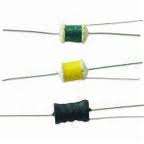Trigger transformer
A Trigger transformer is a small, usually ferrite cored transformer used in applications requiring a high voltage pulse, typically to start ionization of a gas to allow a current to pass.[1]
Uses

A commonly used device requiring a trigger transformer are strobe lights. Strobe lights consist of a tube containing an inert gas, such as xenon. Capacitors inside the light are charged up to a relatively high voltage, roughly 300 Volts for small strobes. This voltage itself is not capable of ionizing the gas in the flash tube, and the tube will not fire.[2] If the capacitors were charged to a voltage high enough to ionize the tube, the result would be no longer a flash, but a continuous arc as the voltage is sufficient to maintain ionization in the flash tube.
Once the main storage capacitor has finished charging, a smaller capacitor is discharged into the trigger transformers primary coil. A large magnetic pulse is generated inside the transformer, which is coupled to the secondary coil through the core. The secondary coil consists of hundreds, or even thousands of windings of very fine copper wire so a high voltage pulse is generated, in the order of 2-6 kV (2000-6000 V), depending on the length of the flash tube, and the gas contained within the tube. This high voltage pulse overcomes the resistance of the gas, and allows ionization.
Once this ionization exists, the tube offers a much lower path of resistance, for which the main storage capacitor can now release its energy into the tube extremely quickly. By this point, the main storage capacitor is recharging and the trigger transformer ready to create another high voltage spike, and the cycle repeats.
Although strobe lights are the most common use of trigger transformers, other devices such as arc lamps, gas laser tubes and even the common fluorescent light employ trigger transformers, however usually in a different form, such as using an electrical ballast to provide both the high voltage spike, as well as current limiting to prevent the tube from drawing excess current.
Inductors are also commonly used in place of a trigger transformer, however are not considered transformers themselves, although similar in operation.